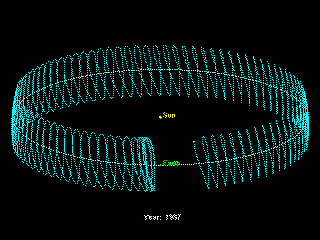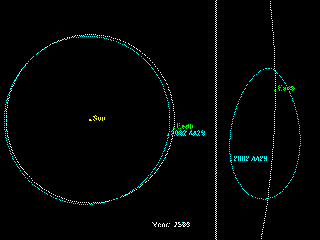



All animations are provided as animated GIFs and should run within your web browser. Animations created by Paul Chodas and Ron Baalke.


This animation shows the location of asteroid 2002 AA29 during the years 2000 through 2005, as it orbits the Sun just ahead of the Earth and matches our planet’s speed almost precisely. The asteroid’s orbit is traced in blue, while the Earth’s orbit is shown in white. During the animation, our point of view lowers down to show how the asteroid’s orbit is tilted relative to the Earth’s. The tilt causes the asteroid to move above and below the Earth’s orbital plane in a yearly cycle.


Like a cameraman hanging off a rotating merry-go-round and filming a person walking on the platform, our view in this animation remains fixed on the Earth as it and the roving asteroid go around the Sun. This view makes the Earth appear fixed and shows just the motion of the asteroid relative to our planet. The animation begins in 1903, with asteroid 2002 AA29 on the trailing side of the Earth. In this oblique view, the asteroid bobs up and down in a yearly cycle because of its orbital tilt.
For the first few years after 1903, AA29 loops towards the Earth, but then reverses direction and traces a path all the way around the Earth’s orbit until it reaches its current position on the leading side of our planet. On January 8, 2003, the asteroid will approach the Earth to about 15 times the distance of the Moon, then reverse its direction once again, and head back to our planet’s trailing side.


This animation shows two views of the predicted motion of asteroid 2002 AA29 when it becomes a quasi-satellite of the Earth 600 years from now. On the left, we can see how both the asteroid and the Earth follow similar orbits about the Sun. When we keep the Earth fixed with the Sun always to the left, as on the right, the asteroid appears to follow a closed loop around our planet. It cannot be considered a true satellite of the Earth during this time because the asteroid will be too distant for the Earth’s gravity to exceed the Sun’s control over the body’s motion.